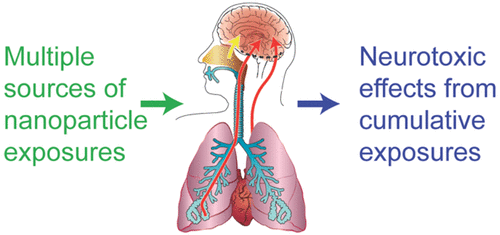当前位置:
X-MOL 学术
›
Chem. Res. Toxicol.
›
论文详情
Our official English website, www.x-mol.net, welcomes your
feedback! (Note: you will need to create a separate account there.)
Neurotoxicology of Nanomaterials.
Chemical Research in Toxicology ( IF 3.7 ) Pub Date : 2020-04-14 , DOI: 10.1021/acs.chemrestox.0c00050 William K Boyes 1 , Christoph van Thriel 2
Chemical Research in Toxicology ( IF 3.7 ) Pub Date : 2020-04-14 , DOI: 10.1021/acs.chemrestox.0c00050 William K Boyes 1 , Christoph van Thriel 2
Affiliation

|
The remarkable advances coming about through nanotechnology promise to revolutionize many aspects of modern life; however, these advances come with a responsibility for due diligence to ensure that they are not accompanied by adverse consequences for human health or the environment. Many novel nanomaterials (having at least one dimension <100 nm) could be highly mobile if released into the environment and are also very reactive, which has raised concerns for potential adverse impacts including, among others, the potential for neurotoxicity. Several lines of evidence led to concerns for neurotoxicity, but perhaps none more than observations that inhaled nanoparticles impinging on the mucosal surface of the nasal epithelium could be internalized into olfactory receptor neurons and transported by axoplasmic transport into the olfactory bulbs without crossing the blood-brain barrier. From the olfactory bulb, there is concern that nanomaterials may be transported deeper into the brain and affect other brain structures. Of course, people will not be exposed to only engineered nanomaterials, but rather such exposures will occur in a complex mixture of environmental materials, some of which are incidentally generated particles of a similar inhalable size range to engineered nanomaterials. To date, most experimental studies of potential neurotoxicity of nanomaterials have not considered the potential exposure sources and pathways that could lead to exposure, and most studies of nanomaterial exposure have not considered potential neurotoxicity. Here, we present a review of potential sources of exposures to nanoparticles, along with a review of the literature on potential neurotoxicity of nanomaterials. We employ the linked concepts of an aggregate exposure pathway (AEP) and an adverse outcome pathway (AOP) to organize and present the material. The AEP includes a sequence of key events progressing from material sources, release to environmental media, external exposure, internal exposure, and distribution to the target site. The AOP begins with toxicant at the target site causing a molecular initiating event and, like the AEP, progress sequentially to actions at the level of the cell, organ, individual, and population. Reports of nanomaterial actions are described at every key event along the AEP and AOP, except for changes in exposed populations that have not yet been observed. At this last stage, however, there is ample evidence of population level effects from exposure to ambient air particles that may act similarly to engineered nanomaterials. The data give an overall impression that current exposure levels may be considerably lower than those reported experimentally to be neurotoxic. This impression, however, is tempered by the absence of long-term exposure studies with realistic routes and levels of exposure to address concerns for chronic accumulation of materials or damage. Further, missing across the board are "key event relationships", which are quantitative expressions linking the key events of either the AEP or the AOP, making it impossible to quantitatively project the likelihood of adverse neurotoxic effects from exposure to nanomaterials or to estimate margins of exposure for such relationships.
中文翻译:

纳米材料的神经毒理学。
纳米技术带来的显着进步有望彻底改变现代生活的许多方面;然而,这些进步伴随着尽职调查的责任,以确保它们不会对人类健康或环境造成不利后果。许多新型纳米材料(至少一维<100 nm)如果释放到环境中可能具有高度流动性,并且反应性也很强,这引起了人们对潜在不利影响的担忧,其中包括潜在的神经毒性。一些证据引起了人们对神经毒性的担忧,但也许无非是观察到,吸入的纳米粒子撞击鼻上皮粘膜表面可以被内化到嗅觉受体神经元中,并通过轴浆运输转运到嗅球而不穿过血脑障碍。人们担心纳米材料可能会从嗅球传输到大脑更深处并影响其他大脑结构。当然,人们不会只接触工程纳米材料,而是会发生在环境材料的复杂混合物中,其中一些是偶然产生的颗粒,其可吸入尺寸范围与工程纳米材料相似。迄今为止,大多数纳米材料潜在神经毒性的实验研究都没有考虑潜在的暴露源和可能导致暴露的途径,大多数纳米材料暴露的研究也没有考虑潜在的神经毒性。在这里,我们对纳米颗粒的潜在暴露来源进行了回顾,并回顾了有关纳米材料潜在神经毒性的文献。我们采用聚合暴露途径(AEP)和不良结果途径(AOP)的相关概念来组织和呈现材料。AEP 包括一系列关键事件,从材料来源、释放到环境介质、外部暴露、内部暴露和分发到目标地点。AOP 始于目标位点的毒物引起分子启动事件,并且与 AEP 一样,依次进展到细胞、器官、个体和群体水平的行动。除了尚未观察到的暴露人群的变化外,AEP 和 AOP 中的每个关键事件都描述了纳米材料作用的报告。然而,在最后阶段,有充分的证据表明暴露于环境空气颗粒会对人口水平产生影响,这些颗粒的作用可能与工程纳米材料类似。这些数据给人的总体印象是,目前的暴露水平可能远低于实验报告的神经毒性水平。然而,由于缺乏具有现实途径和暴露水平的长期暴露研究来解决对材料长期积累或损害的担忧,这种印象受到了影响。更远,
更新日期:2020-04-01
中文翻译:

纳米材料的神经毒理学。
纳米技术带来的显着进步有望彻底改变现代生活的许多方面;然而,这些进步伴随着尽职调查的责任,以确保它们不会对人类健康或环境造成不利后果。许多新型纳米材料(至少一维<100 nm)如果释放到环境中可能具有高度流动性,并且反应性也很强,这引起了人们对潜在不利影响的担忧,其中包括潜在的神经毒性。一些证据引起了人们对神经毒性的担忧,但也许无非是观察到,吸入的纳米粒子撞击鼻上皮粘膜表面可以被内化到嗅觉受体神经元中,并通过轴浆运输转运到嗅球而不穿过血脑障碍。人们担心纳米材料可能会从嗅球传输到大脑更深处并影响其他大脑结构。当然,人们不会只接触工程纳米材料,而是会发生在环境材料的复杂混合物中,其中一些是偶然产生的颗粒,其可吸入尺寸范围与工程纳米材料相似。迄今为止,大多数纳米材料潜在神经毒性的实验研究都没有考虑潜在的暴露源和可能导致暴露的途径,大多数纳米材料暴露的研究也没有考虑潜在的神经毒性。在这里,我们对纳米颗粒的潜在暴露来源进行了回顾,并回顾了有关纳米材料潜在神经毒性的文献。我们采用聚合暴露途径(AEP)和不良结果途径(AOP)的相关概念来组织和呈现材料。AEP 包括一系列关键事件,从材料来源、释放到环境介质、外部暴露、内部暴露和分发到目标地点。AOP 始于目标位点的毒物引起分子启动事件,并且与 AEP 一样,依次进展到细胞、器官、个体和群体水平的行动。除了尚未观察到的暴露人群的变化外,AEP 和 AOP 中的每个关键事件都描述了纳米材料作用的报告。然而,在最后阶段,有充分的证据表明暴露于环境空气颗粒会对人口水平产生影响,这些颗粒的作用可能与工程纳米材料类似。这些数据给人的总体印象是,目前的暴露水平可能远低于实验报告的神经毒性水平。然而,由于缺乏具有现实途径和暴露水平的长期暴露研究来解决对材料长期积累或损害的担忧,这种印象受到了影响。更远,











































 京公网安备 11010802027423号
京公网安备 11010802027423号